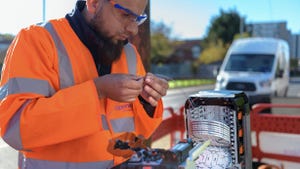Solving Climate Change With Green ICT
Connectivity is changing the future as virtual and real experiences converge to create a multi-dimensional, more diverse world.
October 28, 2021

Connectivity is changing the future as virtual and real experiences converge to create a multi-dimensional, more diverse world. Yet the trend toward digital transformation and mobility also contribute to increased carbon emissions. The ICT industry can play a pivotal role in using new technologies to offset climate change and counter these consumption patterns.
Greater efficiency in the use of digital services offers a critical pathway on that journey. Another is to recognize and follow the three Ds of the new economy: Dematerialization, demobilization, and decarbonization. Major telecoms already have been effective at reducing their own carbon footprint. And operators can be instrumental in helping business enterprises become vastly more efficient in terms of their digital use.
In this article, we look at the increase in worldwide mobile connectivity, explore steps that operators can take to reduce their carbon footprint, and consider the important role that the ICT industry plays in providing solutions for more efficient data transmissions and reducing carbon output.
Fighting climate change with new technologies and initiatives
It’s clear that our consumption patterns are exceeding the earth’s capacity to recycle carbon. Every year, human activity emits approximately 51 billion tons of greenhouse gasses into the atmosphere. These conditions require a systemic change to our current modes of production. And it needs to happen quickly across every industry and economic sector.
The application of new technologies offers the best hope in mitigating the most severe consequences of climate change. Along with new products and initiatives, ICT operators and partners are collaborating through industry forums to share innovative technologies that will contribute to a greener ICT industry. For example, the Network Carbon Intensity (NCI) initiative jointly proposed by the global ICT leader, Huawei and Informa Tech seeks to more accurately define and measure carbon emissions per bit of data.
To be sure, collaboration and green initiatives need to be weighed against the high emission rates of other technologies. For instance, bitcoin processes require enormous energy usage. For example, with its current energy footprint, the digital currency uses 121 terawatt hours of electricity every year. Since digital inefficiencies can have severe consequences, ICT operators need to proactively work together to accelerate green development and make sure every bit of energy is directed to the areas where it’s needed the most.
Operators take key steps toward energy efficiency
The ability to prevent global warming is complicated by the fact that worldwide consumption and greenhouse emissions continue to accelerate. The E.U. forecasts that by 2024, energy use by the ICT industry could increase to 14 percent of all global emissions. One factor in that increase is the dramatic expansion of the Internet of Things (IoT) across homes and industries. The expectation is that total mobile data traffic will rise to 2000 petabytes by 2024, representing an annual growth of 22 percent since 2019.
“We have to bring the carbon levels down and the ICT has a major role to play in providing a solution,” says Richard Mahony, Vice President of Service Provider Markets at Informa Tech. “The only route we have is through greater efficiency. We have to be individually accountable to do everything we can to reduce our carbon footprint.”
Reducing emissions through more efficient use of technology can create a pathway to net zero for operators. Industry leaders have identified four sources for increased ICT efficiency. The first green initiative is to migrate to fifth generation (5G) wireless because it’s 90 percent more efficient at transmitting data than 4G. The faster connection speeds of 5G will enable innovations in energy production, transmission, distribution and usage. For example, 5G will be instrumental in unleashing the next wave of smart grid features and efficiencies.
Next, operators and partners can achieve 15 percent energy savings by replacing inefficient networks. Telcos can also transmit data far more efficiently over fiber. The third initiative replaces copper cabling with fiber-to-the-home (FTTH) alternatives to cut energy use by 85 percent. Finally, by optimizing their data centers companies can achieve a further 35 percent savings. These pathways to net zero also align with ICT initiatives to help other industries cut their carbon emissions and become carbon neutral faster.
The three Ds of today’s new economy can help reduce the energy consumption in our society at large: Dematerialization converts physical products to digital. Demobilization minimizes energy usage in the form of employee travel, encouraging online meetings and collaborations or remotely maintaining equipment. And Decarbonization promotes the smarter use of energy with the goal of reaching 100 percent decarbonization of the current power system by 2040.
Huawei Technologies Co. Ltd
This content is sponsored by Huawei. The Light Reading editorial staff has no involvement in producing sponsored content, verifying its accuracy or otherwise ensuring that it meets our editorial standards.
You May Also Like










